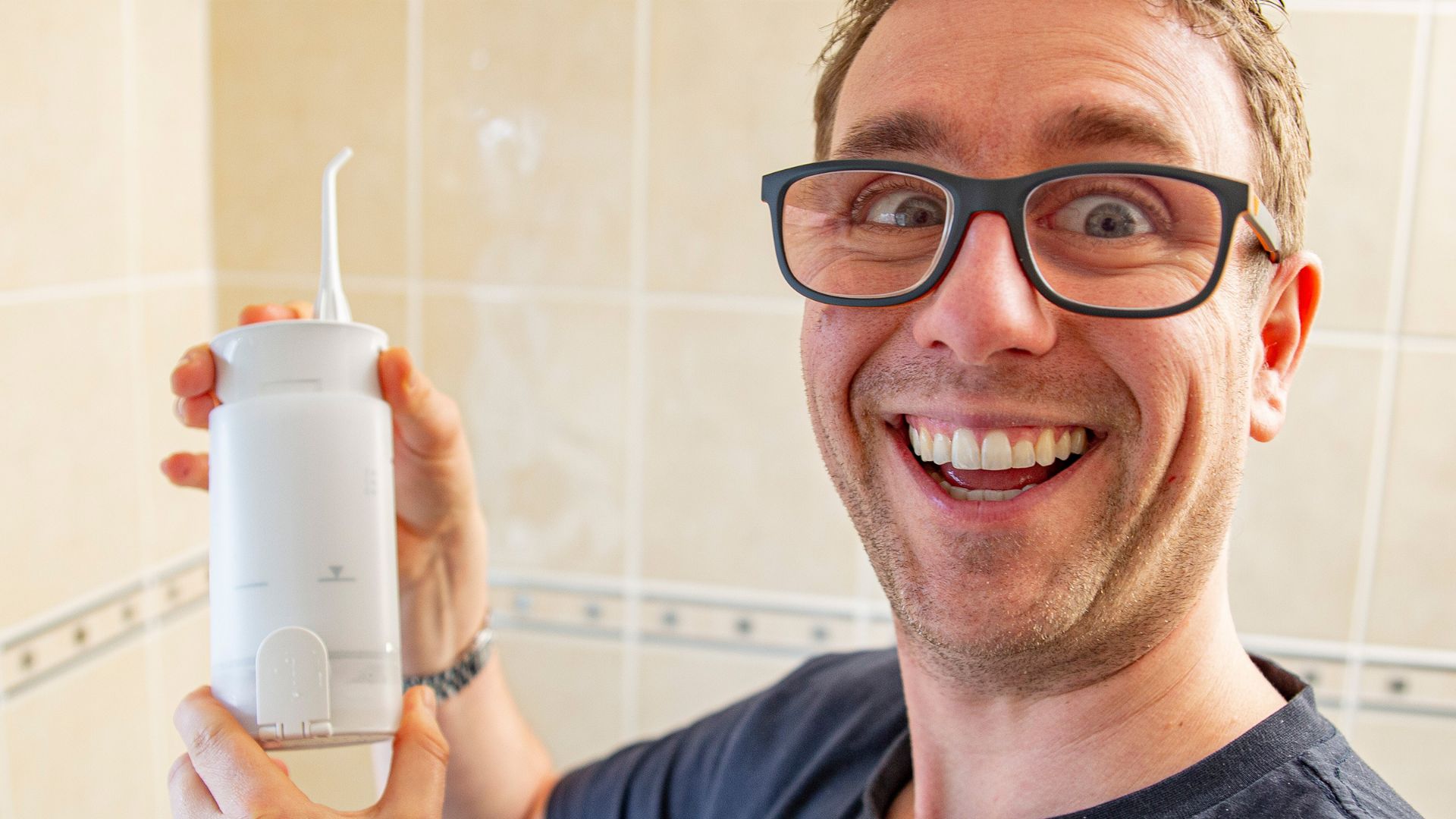
An ideal travel companion
The EW-DJ10 is a collapsible and lightweight flosser that performs well.
Shorter flossing times and a tricky to rotate nozzle are the tradeoffs for portability.

Pros |
Cons |
|---|---|

Collapsible design to reduce the size |
Smallish sized tank |

Clever nozzle storage |
Not the most comfortable to hold |

Powered by AA batteries |
No travel pouch included |

2 pressure settings |
Rotating the nozzle can be a bit awkward |
Consider these other water flossers
Cordless water flossers, by their very design, are more travel friendly than their countertop alternatives.
But, many cordless models can still be bulky to carry when on the move, even our top choice, the Waterpik Advanced.
The EW-DJ10 is fairly unique in the collapsible form factor matched only by the Waterpik Cordless Slide.
There are many similarities between them and in some respects, Panasonic has the edge with the clever nozzle storage.
But, the Slide has a rechargeable battery and travel pouch. And of course, there is something to be said for the peace of mind that comes from using the leading brand.

Design, usability, clean & general use
Water flossers are a popular alternative to string floss or interdental brushes.
They might not be quite as effective, but they can be more convenient for everyday use.
The EW-DJ10 from Panasonic has been designed to appeal to the traveler.
It is one of only a select few to have a collapsible design, allowing it to reduce in size when not in use so that it can be conveniently packed away in a bag for travel.
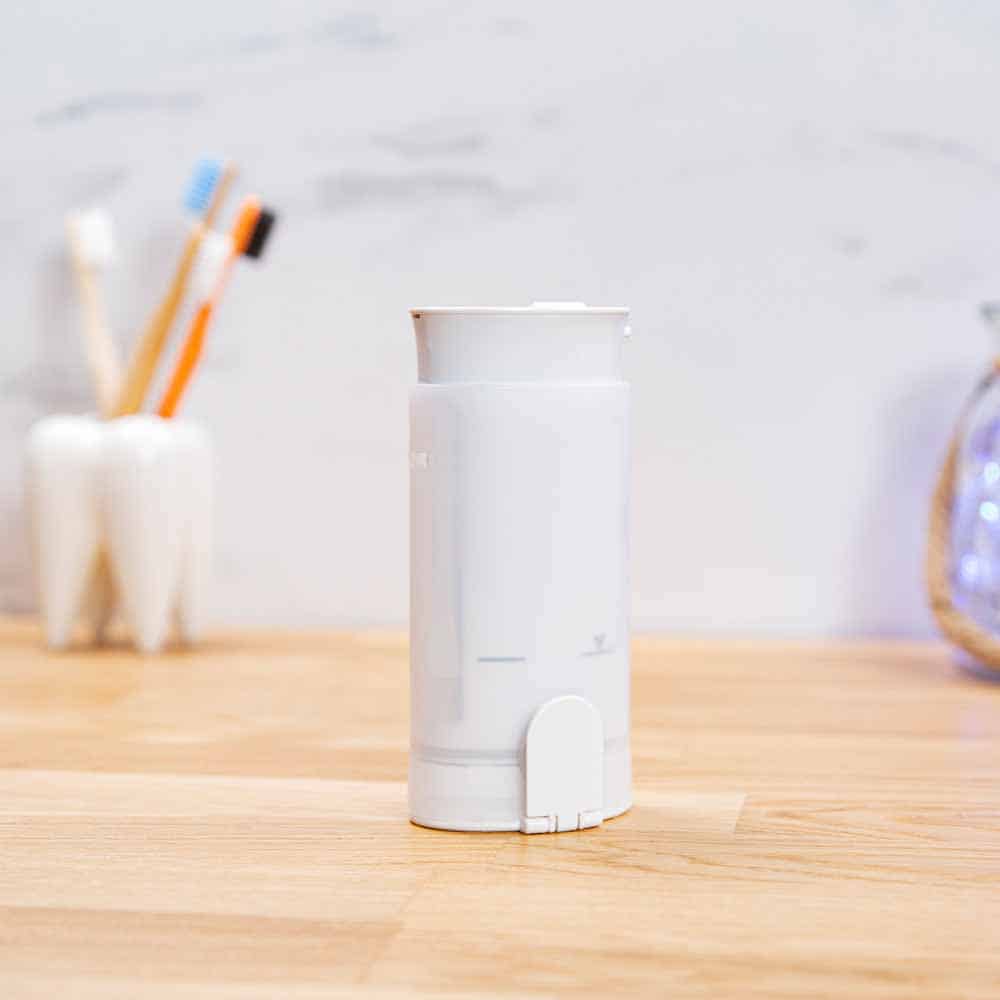
To work effectively and give enough flossing time, a water flosser uses quite a bit of water.
The best water flossers are corded and sit on a countertop, this is to accommodate the larger water tanks for extended flossing times. This doesn’t serve those on the go quite so well.
Cordless and more travel friendly options exist, but they have smaller water tanks and are still relatively bulky all things considered.
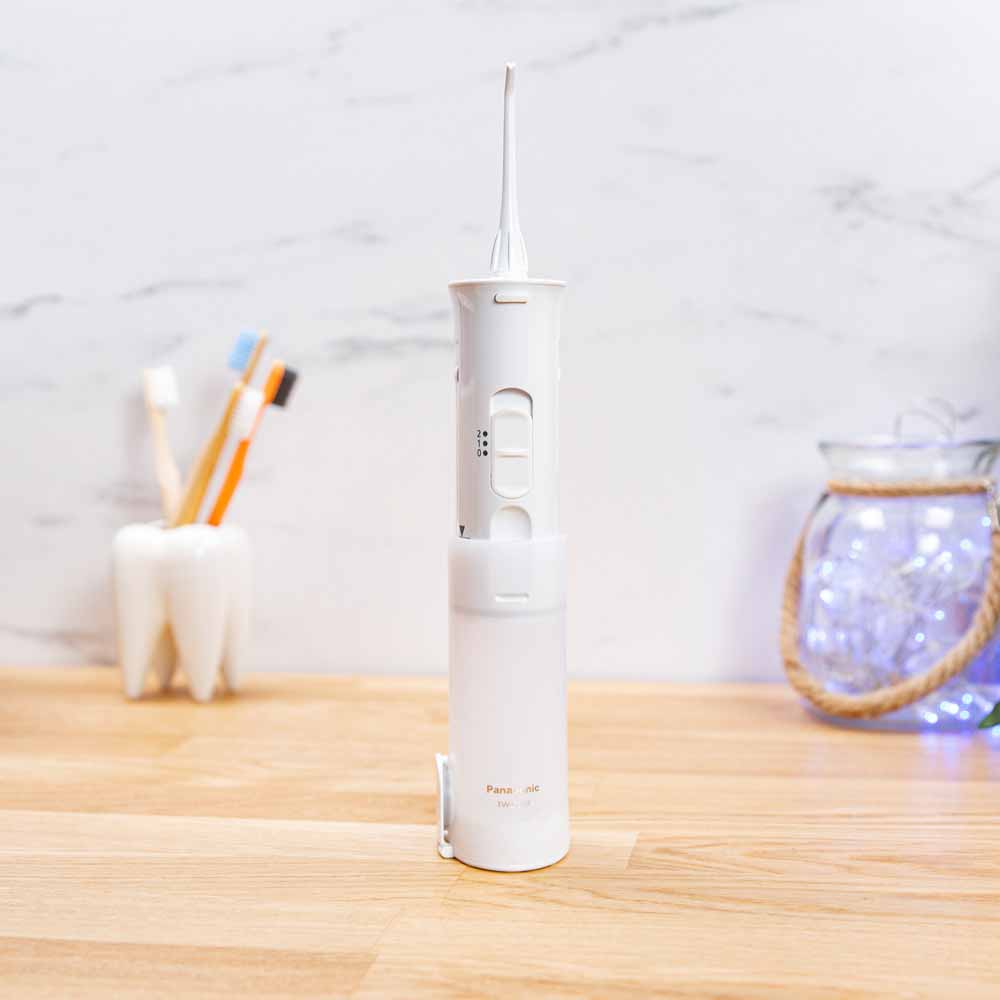
The Panasonic doesn’t really overcome the water tank size issue. It has a 5.5 ounce (165ml) reservoir but the collapsible design is simple and effective.
Take the Cordless Advanced from Waterpik, it is a great unit, but whether in use or in a travel bag it measures 11.6 inches tall, 2.8 inches wide and 4 inches deep.
The EW-DJ10 isn’t too much different when extended. It too is 11.6 inches tall and is 2.7 inches wide and 2 inches deep.
But, remove the nozzle and collapse it and it reduces to just 5.6 inches. It is half the height. That is a lot less space to consume in a bag. If you are traveling light this makes a big difference.
It is also lighter too. Even with batteries, it weighs in at 9.28 ounces compared to the 12.8 of the Cordless Advanced.
You essentially have 2 parts to the water flosser.
There is the main unit that contains the battery and pump etc and then you have the water tank. The tank clips over and wraps around the main unit. Meaning when collapsed the main unit sits within the water tank essentially.
When you want to use it, you pull the 2 pieces away from each other, they slide apart until the top of the tank aligns with an arrow on the lower edge of the main unit.
The hands-on images throughout this review best demonstrate what it looks like and how it works.
You must fully extend, the reservoir to use it. When full it holds approx 5.5oz (165ml) of water.
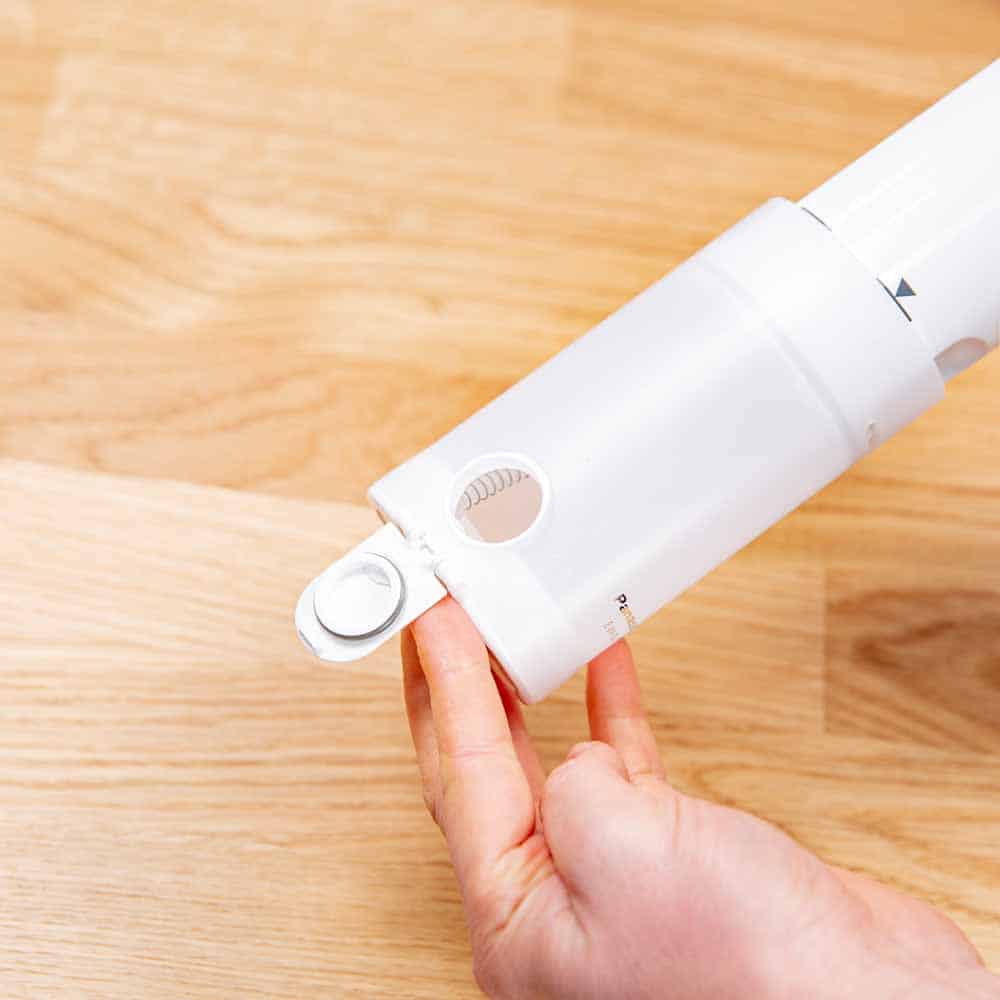
On one side of the tank is a hinged door that folds back on itself. It has a circular opening that aligns with an o-ring seal on the lid that keeps the liquid inside when closed.
Opening the compartment lid is advised to make extending the unit easier too.
When extended, the tank sits securely in place. It doesn’t feel like it is going to collapse at any moment. In fact, to collapse it you need to give both parts a firm push to slide closed.
A nice touch is that you can remove the water tank entirely for cleaning purposes. The opening is large enough that you can access it easily enough to clean it properly too. Some other flossers have removable tanks, but effectively cleaning inside is difficult.
The unit has a flat base and stands upright on a countertop whether extended or not.
A very clever touch, particularly considering the travel friendly design of this product is the storage section for the nozzle.
On the back of the unit is a recess into which the detachable nozzle can be placed. This means when collapsed the nozzle is tucked inside the water tank for safe storage. You can then access it again as you pull the main body out of the tank.
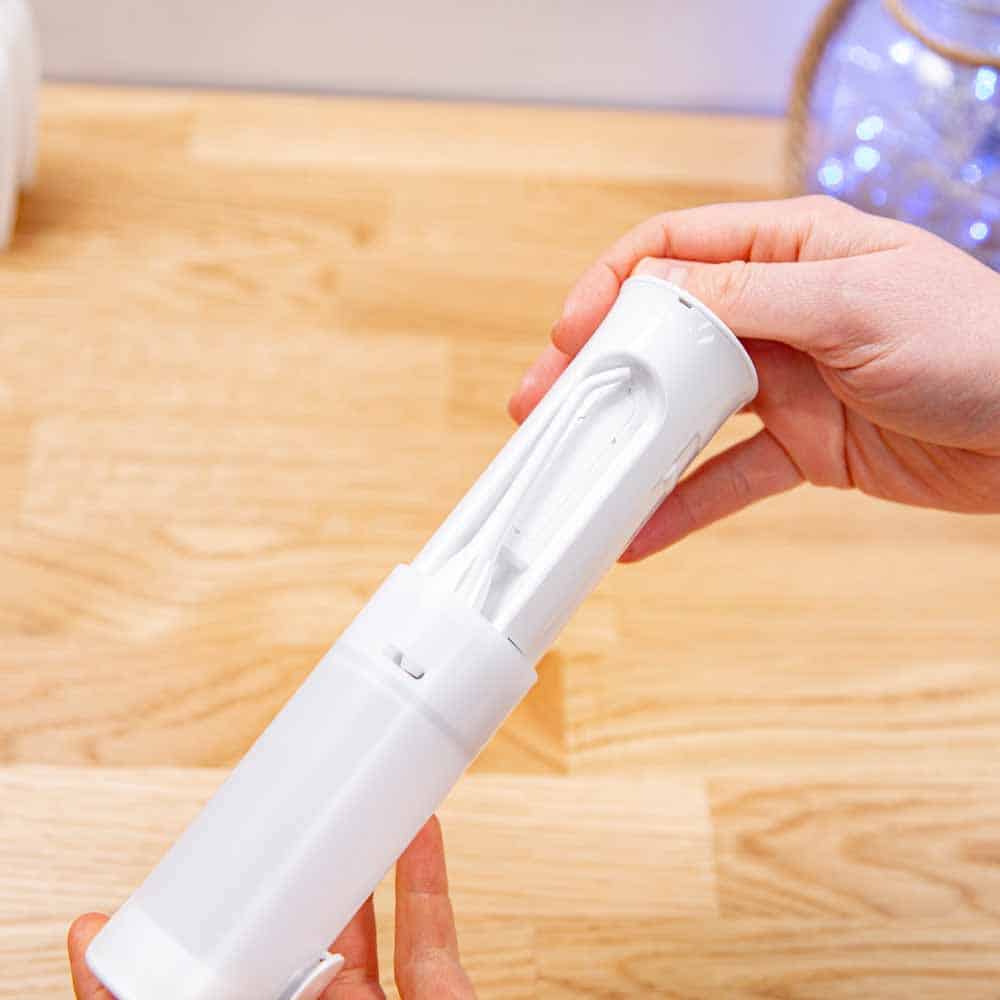
The whole unit has an elliptical design to it. It is smart and helps the unit to feel a bit more comfortable in hand.
I do have to be honest and say it isn’t the most comfortable to grip. It is a bit awkward and there is a harsher edge at the top of the unit that isn’t ideal.
You do too lack a few textured surfaces for grip. I don’t think you will drop it, even when wet, but you just don’t get the same sense of security in the hand as you do with others.
That said, you might find, like me, that your fingers rest in the nozzle storage area at the back of the unit as you hold it. This gives more purchase and security in the hand.
On the front of the unit is a slider switch with 3 positions. The first is labeled 0 and is the off position. 1 is the lower powered ‘soft’ mode and 2 is the normal and full power mode.
The slider has a raised design in the middle so it is easy for the finger or thumb to use. It is nice and smooth, with obvious clicks as you hit each position.
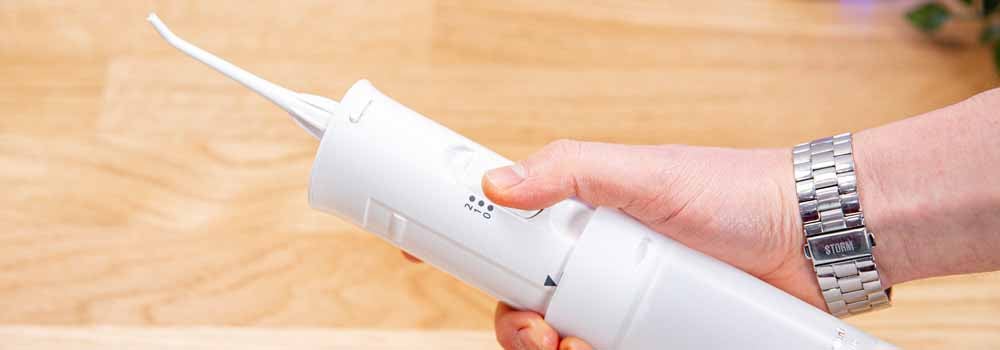
At the top edge is a small button you press to release the nozzle that sits on the top of the unit.
The nozzles clips into the hole on the flat top of the unit.
When pushed into place, it will click in and you won’t be able to remove it unless you press the eject button.
The nozzle does rotate a full 360 degrees when fitted and the finned design towards the bottom of the nozzle helps the fingertip grip to and twist when in the mouth.
Although it rotates, the position and surface area of the nozzle, along with the harsher edge of the flosser, means turning the nozzle whilst in use, isn’t quite as simple or comfortable as other cordless units.
Perhaps I haven’t found the correct hand position and technique, but there are definitely better implementations amongst competing products.
Replacement nozzles are sold in packs of 2 and typically cost around $12. Part number EW0955W is what you need. You will have to go online to find these. Even then they are not widely sold.
The nozzles are white in color, but do come with a removable ring at the bottom. The color of the ring supplied does differ, so in theory, you can have different colored rings for different users.
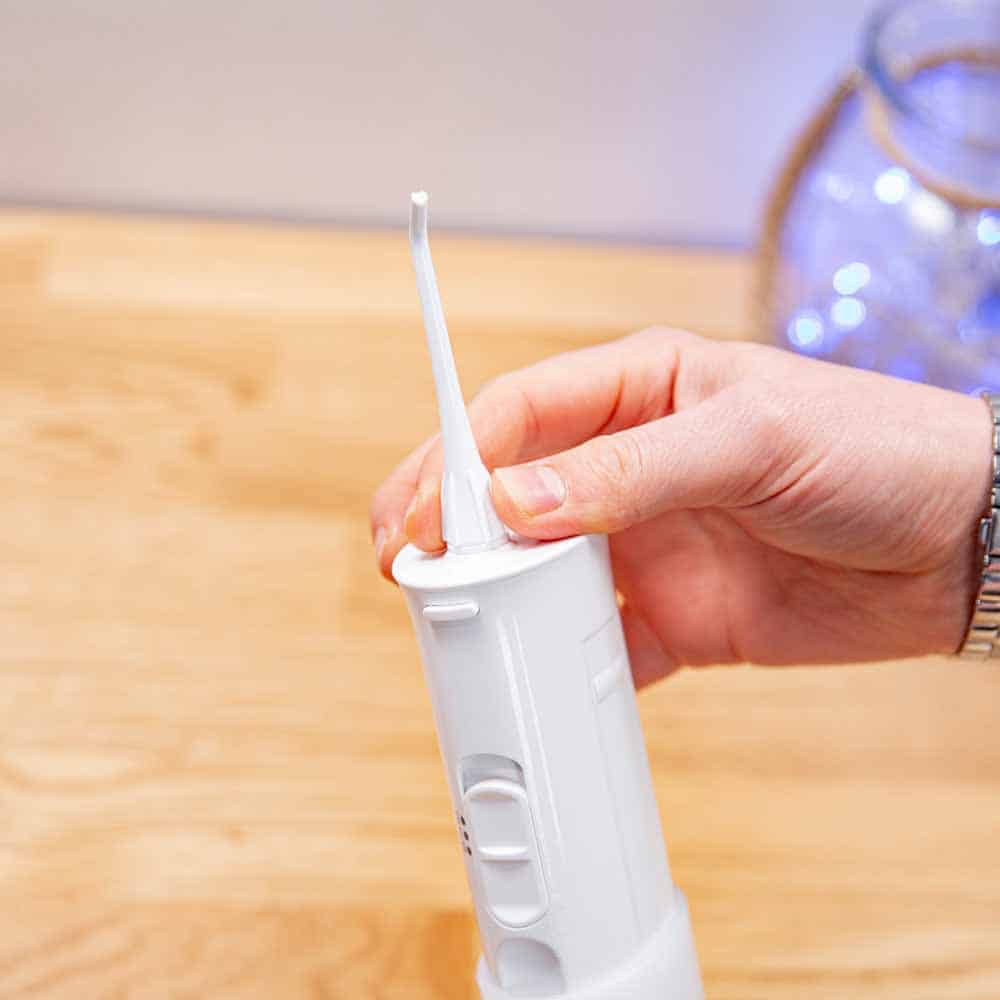
There is no choice of nozzles, no different styles or designs that are suited to different users.
Those with periodontal pockets, braces, or implants might find the more diverse range of jet tips from Waterpik to be more suitable
Panasonic suggests 40 seconds of usage time from a full tank.
In my hands-on testing, I achieved:
- 50 seconds from the higher powered ‘normal’ mode (position 2 on the slider)
- 60 seconds with the lower speed ‘soft’ mode (position 1 on the slider)
With either, I found this just enough time to achieve a full floss of the mouth. Less experienced users or those wanting a more thorough clean may choose or need to refill.
I have found many other water flossers drain faster and require refills to achieve a thorough floss.
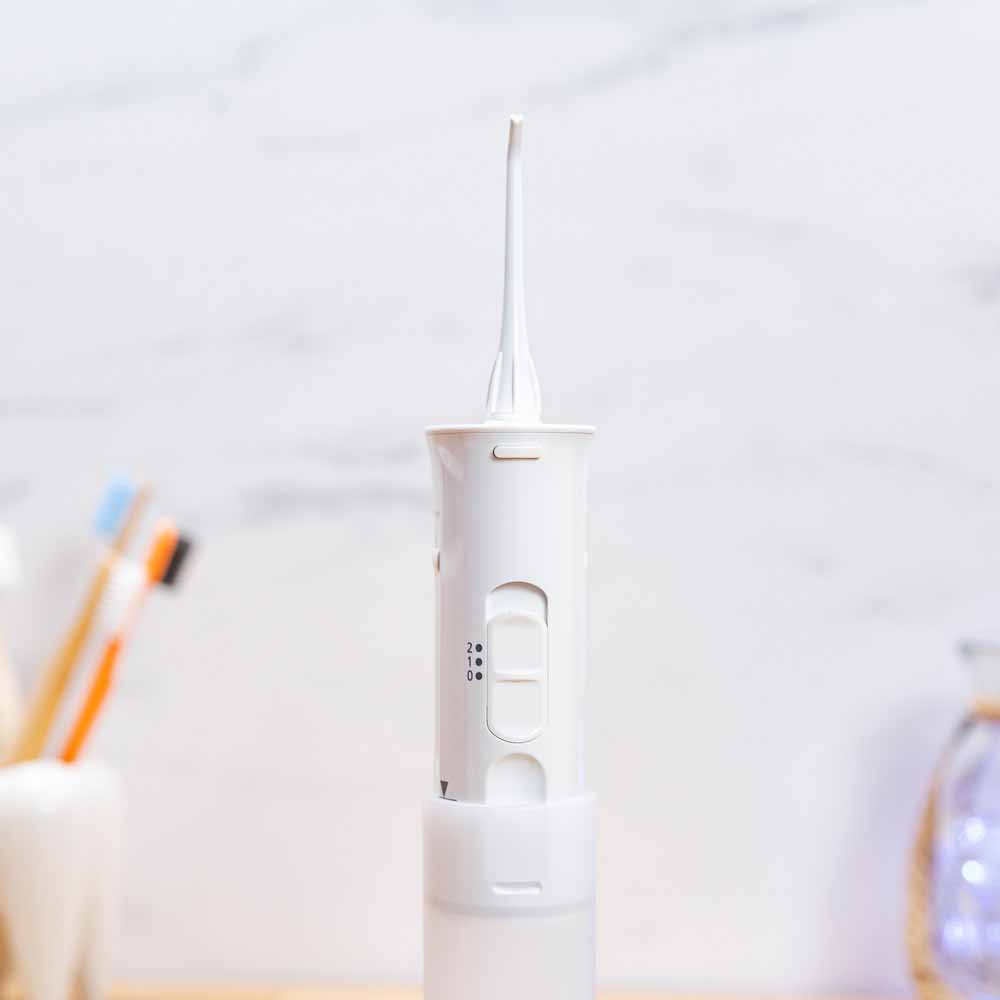
The maximum pressure or power if you like from the normal mode is 530 kilopascal or approximately 77PSI.
Panasonic hasn’t stated these figures for the soft mode.
Waterpik models tend to offer on their cordless units 45 and 75 PSI. The EW-DJ10 appears, to me at least to be comparable in that regard.
When using the normal mode, the DJ10 offers 1400 pulses of water per minute to blast away the debris and plaque that exists in the mouth.
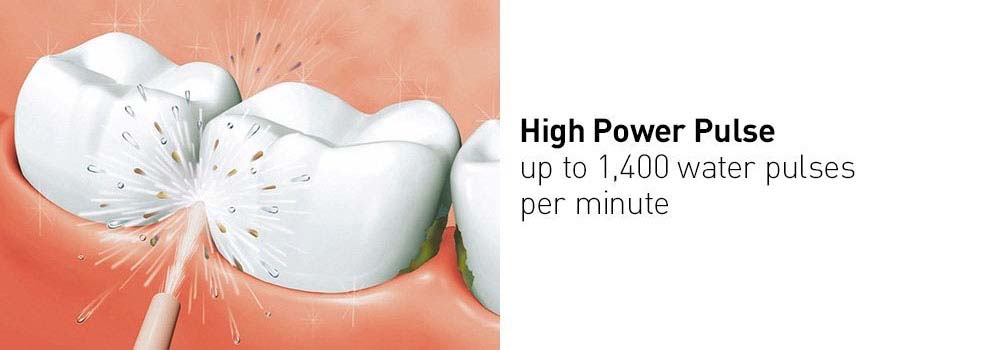
I have to say I have been pleased with the results. My testing is by no means scientific, but I don’t think it is unfair to say the results have been comparable to the competing products. For my fairly normal set of teeth, I haven’t noticed the flosser struggling or succeeding any better than others.
The pressure is only one part of the cleaning process. Flossing technique is another. More power doesn’t always mean a better clean.
Panasonic describes the technique well in their manual. Essentially you want to have the water flowing at 90 degrees/perpendicular to the tooth and gumline. You shouldn’t direct the water down into the gums.
You move along the gumline, pausing between each tooth briefly. You do this for the front and back of the teeth in each arch.
If you are not used to water flossing, it does take some getting used to. It can be messy and you do need to be lent over a sink to expel the waste water.
Don’t be surprised if you spray a bit of water across the bathroom, it happens, even with experienced users.
Rather disappointingly there is no travel pouch included. It isn’t a deal breaker, but I think it would have been a nice extra touch.
Pansonic suggests running the flosser for a couple of seconds once all the water has been drained from the tank, to ensure no residual water is left in the unit. But, there is still a chance some might be left behind and a pouch would have helped protect other items in your travel bag.
And finally, the whole unit is waterproof so it can be rinsed under a tap and used in the shower if you desire.
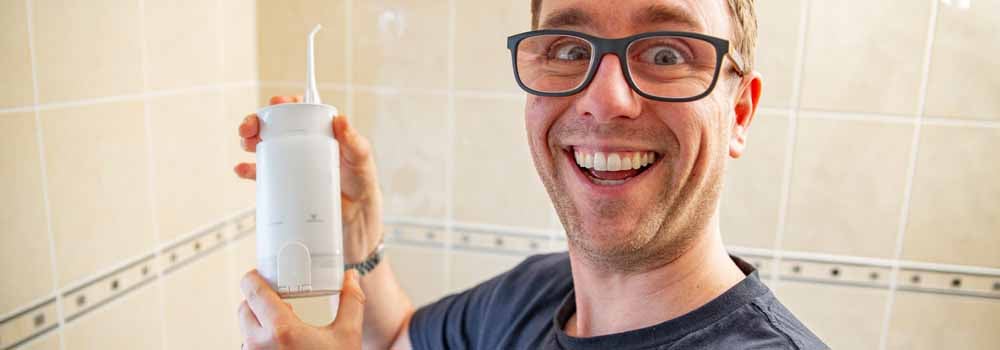
All things considered, there is a lot to like here. Yes, it doesn’t feel quite as good in the hand and it might not have the variety of nozzles, but it does a lot of things well.
Summary of design, usability, clean & general use
Battery life
One of the appeals of this Panasonic water flosser is the fact that it is powered by 2 x AA batteries.
I received 2 in the box, despite the manufacturer and product descriptions online suggesting they wouldn’t be surprised. Just be aware you might not get any included.
The battery compartment is on the top of the flosser for easy access.
A screw in cap seals the compartment shut and stops water from getting in.
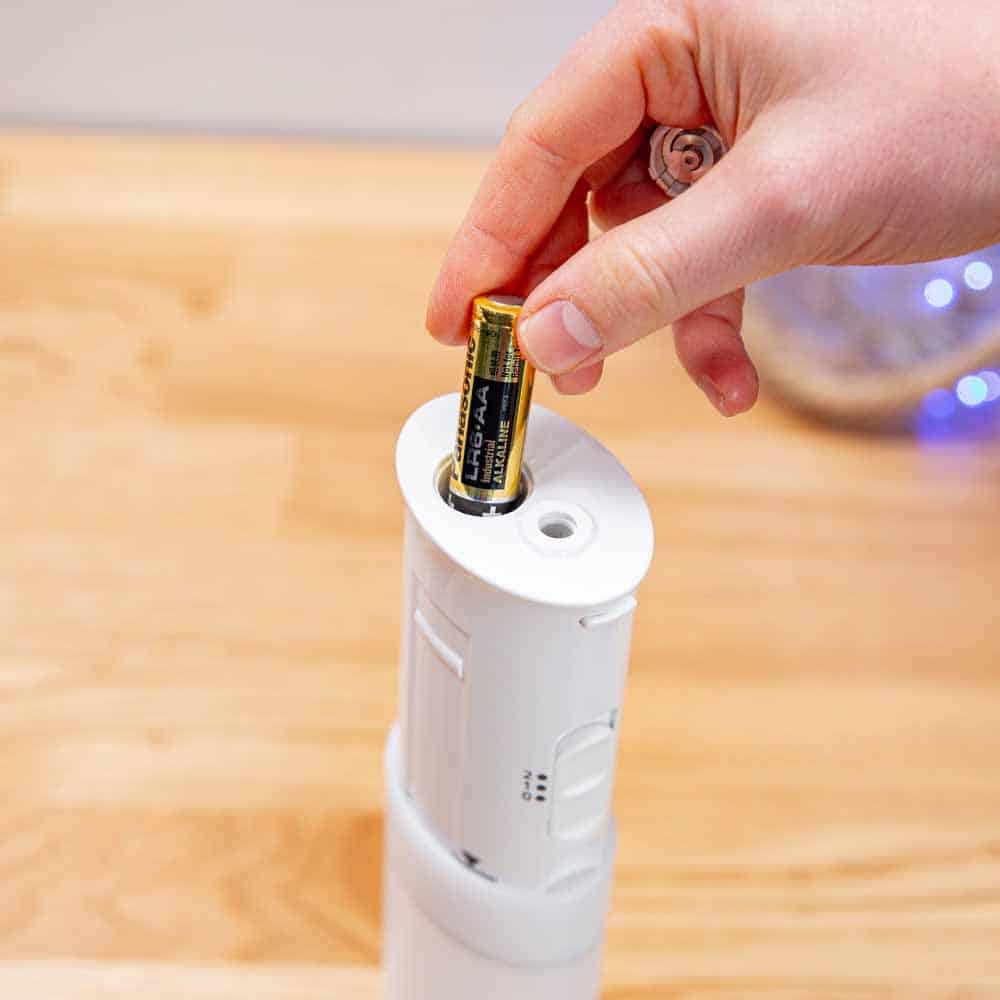
You will need a flat head screwdriver or a coin to insert into the recess to unscrew the cap. Once released, the 2 batteries can be inserted and the cap screwed back in place.
I applaud the positioning and how well the compartment seals shut. But it is a bit frustrating to need a coin or screwdriver to undo this. It isn’t a massive problem, just a slight inconvenience in what is otherwise a travel friendly product.
Most Waterpik units for comparison's sake tend to allow access to the compartment by twisting something. No tools are required. In Panasonic's defense, the Waterpik units are a touch bulkier.
Panasonics' own technical specifications would suggest you get 20 minutes of usage time from the batteries. This is around a month's use before they require replacement. This does assume a typical use pattern of once a day.
I don’t think this is great to be honest. Having to change them every month isn’t ideal.
My own hands-on testing would suggest you should be able to get in the region of 50 minutes use from them, so that is about 2 months use.
Given that batteries can vary in quality and performance it is difficult to say precisely how long you will get when you replace the batteries. A month should be the minimum, but it is very likely you will get a lot longer.
Also having an impact will be how long you floss for and which setting you use.
My testing has been based on using mode 2, the normal and most powerful option.
Because the batteries are AA’s rather than a built-in rechargeable type, there is no warning when the batteries are low aside from the power of the unit decreasing or stopping.
You don’t get a battery status LED to give feedback on the remaining power etc.
Therefore you may want to carry a spare set with you. But, even in more remote locations AA batteries are generally easy to buy.
No option exists to connect this to mains power.
Summary of battery life
Price & where to buy
I have included links to buying options here at the start of the review.
In the section below, I discuss the price more generally and in relation to similar products.
A product is only worth what you are prepared to pay for it, so arguably those looking for a compact water flosser will be willing to spend a little more than most.
But, is the EW-DJ10 being offered at a fair price?
The retail price is around $40 which I know from experience is low.
Given the brand reputation of Panasonic, I had expected higher. At $40 it is in the realms of competing with the lesser known brands and certainly makes the $100 price tag of some Waterpik products look pricey.
The good news is that the typical selling price is actually a bit less. Expect to pay on average around $36 for the EW-DJ10 cordless flosser. Get lucky and you might be able to buy it for just $30 as I did.
As a result of this typical pricing, don’t expect more significant discounts at particular promotional times of the year. You are unlikely to be able to save tens of dollars here.
For this price, you will get the unit itself and 1 nozzle, and 2 AA batteries.
Nozzles should be replaced every 6 months. A pack of 2 usually costs around $12, so $6 each. Don’t expect to find them in your local Walmart. You will need to shop online and even then availability isn’t that great in my experience.
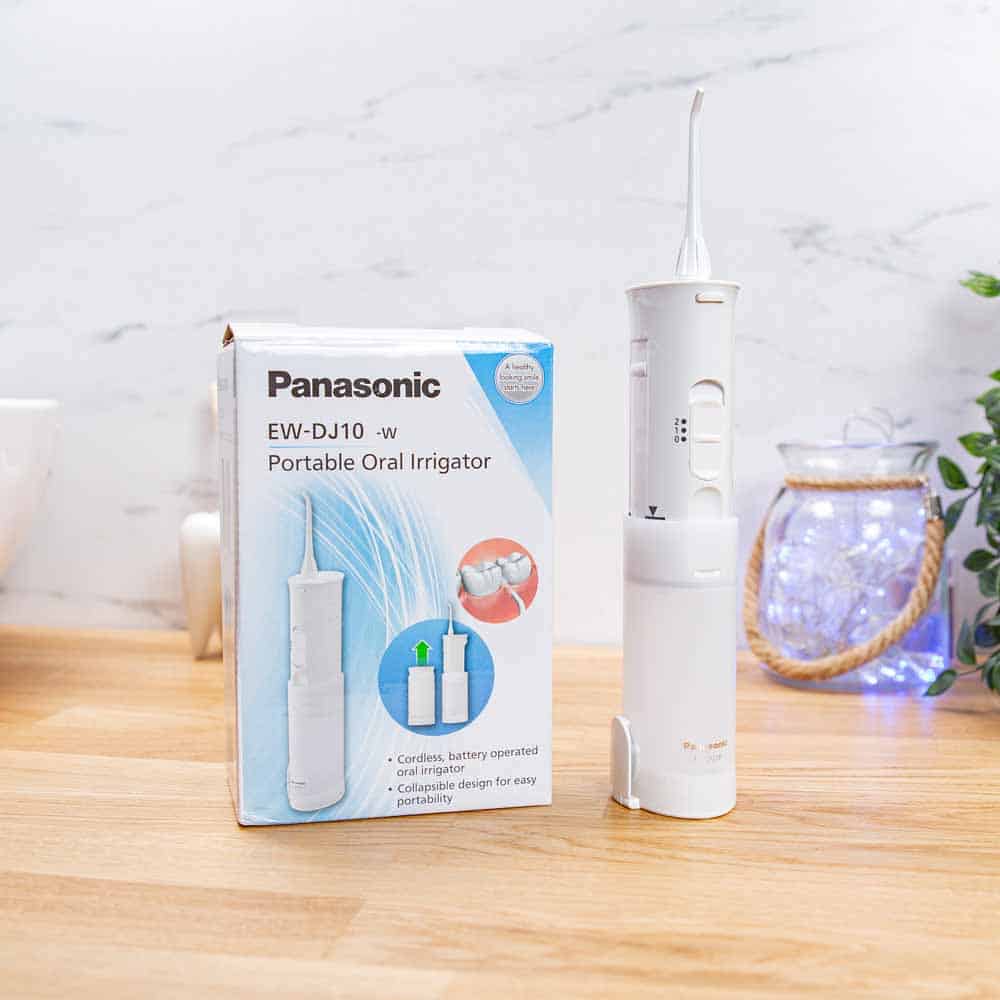
Here at Electric Teeth we like to price things over a 3 year period, to give a bit of a benchmark for comparison with other products of this type.
Thus over 3 years, you will need to purchase 5 nozzles at an additional cost of $30.
Add this to the purchase price of around $36 and you have a total price of $66.
This is before you include batteries though.
Now, this is definitely not an exact science as battery life and usage time varies between different battery brands and there is some dispute on the typical usage time you will get from the Panasonic with 2 AA batteries. However, to keep things simple I am going to assume battery replacement every 3 months at a cost of $0.75 per battery. This is $1.50 every 3 months.
Over 3 years this adds $16.50 to the cost and brings the total ownership total to $82.50.
This is more expensive than the Waterpik Cordless Select, with its rechargeable battery. And it is only $20 less than our top choice, the Waterpik Cordless Advanced.
Adding in the cost of replacement batteries certainly makes this more expensive than some of the competing rechargeable options. But, AA batteries do bring versatility to the package you don’t get with many others. And you still have the collapsible design to consider here too.
Please note that all prices quoted are approximates and will vary based on location, supplier and time of purchase. These figures were correct at the time of writing and should not be relied upon as hard fact, but used as a guide during your decision process.
Summary of price & where to buy
Reliability & long term use
This is the first Panasonic water flosser I have tested.
A few weeks of hands-on testing have not given me any cause for concern in regards to the build quality and reliability.
No specialist tests are performed here at Electric Teeth, we use the products just like you would at home.
Others using this flosser have reported reliability issues including failing pressure in the water flow and general poor reliability.
I am unable to make comment on particular cases, the very nature of the product means that some will likely fail and for this, there is a 2 year warranty that covers mechanical faults and labor.
You do even have a 30 day money back guarantee if you decide you don’t like it. Details of how to claim are included in the box.
To avoid any bacteria or mold buildup, clean the device regularly and thoroughly as described in the provided instructions and keep the unit in a well ventilated area if you can to allow it to dry out thoroughly.
Conclusion
The collapsible design has to be the Panasonic’s best feature, making it particularly appealing to those who travel or like to have a flosser with them most of the time.
It does what others of this type fail to do, keep the size small.
2 pressure settings and user removable AA batteries are a bonus too.
Overall performance is good.
I don’t think it is perfect, but it is hard to complain when you consider the overall package on offer here.
Whilst Panasonic is a household name, they don’t do a lot to promote their products, nor do they have the most extensive range of oral care products. This might be a cause of concern for some.
Ultimately there is little I can fault with the Panasonic. For those wanting something particularly compact, consider the Slide from Waterpik also.
Size guide
- Water Flosser Height With Nozzle - 29.5cm / 11.6 inches
- Water Flosser Height Without Nozzle - 21.8cm / 8.6 inches (Collapsed height - 14.2cm / 5.6 inches)
- Width - 6.9cm / 2.7 inches
- Depth/thickness - 5cm / 2 inches
- Weight with nozzle (no water) - 263g / 9.28oz
- Package weight - 390g / 13.76oz
Noise
- 79dB
Country of manufacture
- China



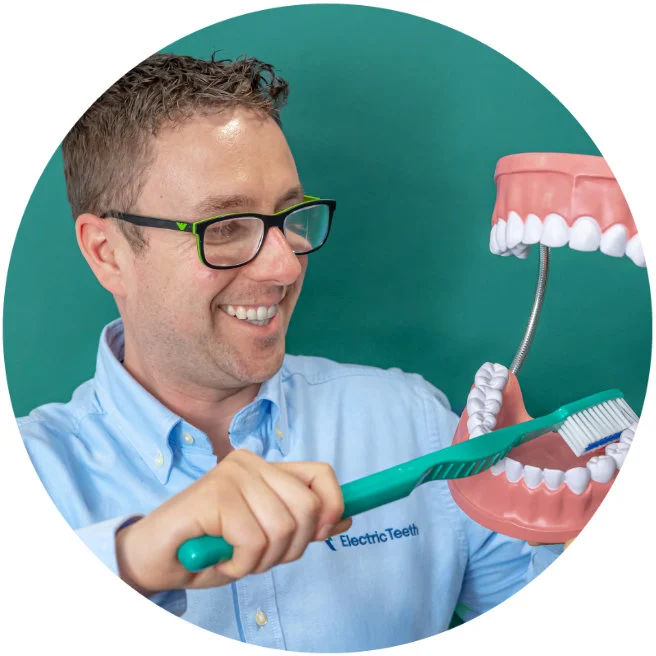
I don't have this exact device, but it might be useful to have a review of its newer, rechargable sibling (EW-DJ4B), because not much reviews are of that one. The new model has a bulit in battery that recharges in 1 hour or less. For me, it lasts for a week with 1 charge (use it once or twice a day). It has 4 intensity levels (highest level is 647 kpa ~98 PSI) with 1600 pulsation (the Waterpik Cordless Advanced has 1400 and max 75 PSI). Note that the way these companies measure pressure is not comparable to actual use mode. The tank is 150 ml and I usually refill once (on level 3-4). It comes with an ultrasonic nozzle (a specific model, so it fits into the side compartment, but you can use the device with any of the Panasonic heads - they have the same connection design). The body is circular, not eliptical, so it is easier to hold. I had no issue with comfort but I struggled with the Waterpic Cordless because it felt heavier, so... each to its own). It also has a level botton with light indicator, not a slider. It remembers the last setting before turning off. It comes with a soft travel poach :D The tank part comes off and can be washed in the dishwasher (max 50°C). The device is IPX7 waterproofed so shower use is still available. I had no performance / suction inconsistency issues with the device. Of course, you have to keep these things in a sorta vertical position to work (true for all cordless water flossers). I have periodontits and veeeery sensitive teeth due to enemel loss (I have some left but... thin layer). Usually, I cannot stand water scaling much, but the time I can tolerate it increased since I use this flosser and the hygienist said my conditions improved a lot. She was sceptical when I showed the device to her but results spoke for themselves over time. I bought it for 45 euros, but they can cost more (I saw it for 80 euros and even higher, too). Nozzle price I don't know, but as I said, all Panasonic nozzles work with it (just not all fit into the groove in the side). I live in a country with extra soft to soft water (according to authorities) so I didn't replace the nozzle yet (I have it since 7 months). I do wash/soak it with hydrogen peroxide once a month, though (just the nozzle). Of course, there are better models out there, but this one I can take with me to work and use it after lunch when I go to the office.
Thanks Edina for sharing your detailed feedback on the newer rechargeable model you have. We are aware of this, but haven't as yet tested it personally. I am sure your comments will be welcomed by many readers of the site.
I've already given my comment on 24th July 2020, including the solution to prevent the sucking of the upper unit of the flosser into the lower water reservoir when it is in operation. But here's additional feedback:- A frequent problem faced by reviewers on Amazon, and which I too experienced, is the frequent erratic "on again, off again" functioning of the flosser. You have to shake it or tap on its body to get it working. My theory - and it works for me - is that the flosser operates on a micro centrifugal pump. If you Google the working of a conventional centrifugal pump you will see that to get it started you need to first "prime" it. That is, fill the housing of the pump with water which also drives out the air. "Dry" running of the pump doesn't build up the energy or suction power to pump up the water. It also vibrates the parts of the pump and damages it. It is only when the air is evacuated from the pump that it can start functioning. What I do is to fill up the flosser reservoir with water, close the inlet cap, hold the flosser vertical, and suck on the nozzle tip till I get water in my mouth(nothing icky about it. After all the nozzle is always in your mouth when you are using the flosser!) With this the housing of the pump is filled with water and the air in it removed, that is, it is "primed." My flosser has worked unfailingly with this procedure. When you finish with your flossing, completely empty out the reservoir through the inlet opening, and again suck on the nozzle and completely drain out the pump housing of the residual water in it(following the manual instruction of turning on the switch to do so entails running it "dry" which will damage the pump). This is my empirical finding, and I can't claim it to be the definitive word on the subject!
Thanks Ramesh for this useful insight.
I've just acquired one, and it worked like a charm. Except for one irritating defect: as you switch on the gizmo and start using it the upper irrigation section gets progressively sucked into the lower water tank. I knew immediately that it was because of the vacuum created in the airtight reservoir as the water was being pumped out of it. The differential air pressure was pushing the irrigator down into the tank. I was wondering whether anyone else had noticed this, and searched in the reviews for the item in Amazon.com. And there was this Mr John Allred who had the same experience, and had come up with a brilliant but simple solution to overcome this problem: drill a small(1/8 inch) hole on the upper part of the water tank, just below where the base of the irrigator ends when it is in the pulled up locked position. This equalizes the air pressure by releasing the vacuum and the balance is maintained. (Note: the hole should be drilled on the side of the tank where the water inlet is situated, and not on the reverse side). Now after carrying out the minor surgery on my acquisition I have no problem with it. I suggest that you access John Allred's review in Amazon.com as apart from explaining his brilliant technique he has even illustrated it with a photograph.
Thanks for the feedback and reference to the idea to relive the pressure. Sounds an ingenious solution to a problem that you and select others have experienced. I do wonder what Panasonic might have said had you contacted them about this issue?
There's no easy way one can get in touch with the manufacturer, M/s Panasonic. I've registered my flosser on their website, but when I tried to give my feedback I found it to be impossible. I was only hoping that someone from the multinational would be periodically scanning the online reviews in Amazon and sites like yours!
My Panasonic water pick s not working. I put new batteries and the water is not coming out from the pick. What should I do? Is it already broken?
I know it's pretty late in the day, but if you still have the flosser please see my feedback dated 2nd April 2021. It might just bring it back to life! Even otherwise you could try it out with any other flosser that you might acquire.
Hi Bernadette. Sorry to hear you are having problems with your flosser. When you power it on, is there any noise from the unit? Does it sound like it is trying to draw the water through, but with no luck? If it doesn't sound like it is working at all, try replacing/repositioning the batteries/making sure they are positioned correctly. Make sure the unit is pulled out correctly. If the unit is not extended correctly, this can stop it working. Also, consider the angle of the unit, keep it more upright to ensure it functions correctly. You can try replacing the nozzle as it may well be damaged or blocked so no water is coming through. If none of this works, you may need to speak to Panasonic.
Good review. Have owned panasonic for awhile. Trying to figure out a better way to clean it. Gets a little grimy on out side behind blue cover. Was wondering how to take it apart. Don't see an easy way
Dale. It is possible to take it apart to clean. Referring to the manual, it says: The tank will come off when the body is pulled hard while the water supply cap is removed. Wash with water and wipe with a cloth.
I pulled it as hard as I could and the tank wouldn't come off. Is there any button one has to press or some other trick?
Not that I recall Steve. I don't have it to hand to check. Perhaps a call to Panasonic support for any other tips is worthwhile.
Just pull it hard.. It will come off
I'll try it. Thanks.